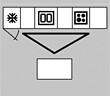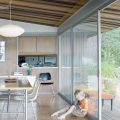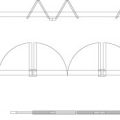Christmas trees green
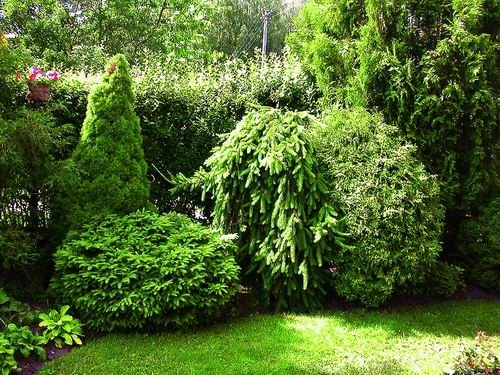 Coniferous plants for the gardenMain advantagemost evergreen conifers - stable decorativeness, which makes large forms desirable elements of the landscape during long winters and dull off-seasons. A solid lifespan - another good reason for the high rating of these plants: a young spruce will eventually turn into a luxurious multi-meter beauty and, perhaps, become a symbol of the "family estate". For ordinary and miniature varieties of many thujas, pines and firs, a naturally formed symmetry of the crown is characteristic, which relieves sybaritic summer residents from the need to master the craft of a garden hairdresser. "For pond owners" You also can't do without evergreen trees and shrubs, since deciduous species planted close to the shore pollute the water and can cause the death of fish. Majestic "patriarchs of the forest" and touching "dwarfs", almost relict species and deliberately artificial varieties, plants with traditionally colored needles and golden, glaucous, blue, as if having forgotten that they belong to evergreens... Once upon a time, only local species of conifers were used in estate landscaping, now dozens of imported species and even more interesting varieties, mainly of foreign selection, have been introduced into the culture. Among those adapted to the Russian climate, there are many plants that can turn an ordinary garden into something special. Representatives of the same genus and even species vary in size, growth rate, color range of needles, bark, cones. Some have a strongly tiered crown, while others are attractive due to their clear columnar or rounded silhouette. In addition to green, blue and silver spruces with the usual crown shape, creeping fir trees, as well as funny "cones", "balls" and "pillows" have become common in Russian gardens. The shape of the inverted spruce (Inversa) is peculiar, and the "exterior" of the snake-like spruce (Virgata) with long, almost unbranched branches is unusually original. Pines are no less popular, and the basis of landscape groups is often formed from native species, and the most "responsible" ones are places are given to mountain pine, European and Siberian. Despite the annually falling needles, larches are in demand, including cultivars of European and Japanese larch, weeping forms grafted onto a standard. Thuja is considered a universal coniferous species. Due to its good winter hardiness and unpretentiousness, one representative of the genus - western thuja, which has numerous "clones" - has become widespread. A worthy place in the garden can be taken by juniper, cypress, fir, yew, as well as almost unknown to us microbiota, thuja, hemlock and pseudo-hemlock.
Coniferous plants for the gardenMain advantagemost evergreen conifers - stable decorativeness, which makes large forms desirable elements of the landscape during long winters and dull off-seasons. A solid lifespan - another good reason for the high rating of these plants: a young spruce will eventually turn into a luxurious multi-meter beauty and, perhaps, become a symbol of the "family estate". For ordinary and miniature varieties of many thujas, pines and firs, a naturally formed symmetry of the crown is characteristic, which relieves sybaritic summer residents from the need to master the craft of a garden hairdresser. "For pond owners" You also can't do without evergreen trees and shrubs, since deciduous species planted close to the shore pollute the water and can cause the death of fish. Majestic "patriarchs of the forest" and touching "dwarfs", almost relict species and deliberately artificial varieties, plants with traditionally colored needles and golden, glaucous, blue, as if having forgotten that they belong to evergreens... Once upon a time, only local species of conifers were used in estate landscaping, now dozens of imported species and even more interesting varieties, mainly of foreign selection, have been introduced into the culture. Among those adapted to the Russian climate, there are many plants that can turn an ordinary garden into something special. Representatives of the same genus and even species vary in size, growth rate, color range of needles, bark, cones. Some have a strongly tiered crown, while others are attractive due to their clear columnar or rounded silhouette. In addition to green, blue and silver spruces with the usual crown shape, creeping fir trees, as well as funny "cones", "balls" and "pillows" have become common in Russian gardens. The shape of the inverted spruce (Inversa) is peculiar, and the "exterior" of the snake-like spruce (Virgata) with long, almost unbranched branches is unusually original. Pines are no less popular, and the basis of landscape groups is often formed from native species, and the most "responsible" ones are places are given to mountain pine, European and Siberian. Despite the annually falling needles, larches are in demand, including cultivars of European and Japanese larch, weeping forms grafted onto a standard. Thuja is considered a universal coniferous species. Due to its good winter hardiness and unpretentiousness, one representative of the genus - western thuja, which has numerous "clones" - has become widespread. A worthy place in the garden can be taken by juniper, cypress, fir, yew, as well as almost unknown to us microbiota, thuja, hemlock and pseudo-hemlock.
From classic to avant-garde
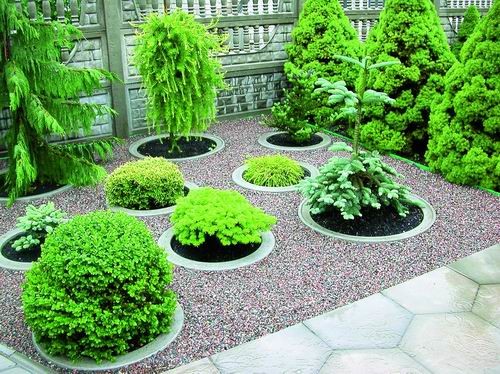 The stylization of the landscape dictates certainтребования ко всем элементам садовых “декораций”, поэтому выбор растений для оформления усадьбы в первую очередь базируется на внешних данных представителей флоры. Хвойная составляющая регулярного парка – растения с правильной формой кроны. На партерном газоне уместна группа голубых елей; структуру коврового цветника задают компактные экземпляры туй, можжевельников, горных сосен. Тенистые аллеи и непроницаемые стены “зеленых кабинетов” принято формировать из колонновидных культиваров туи западной (Колумна, Брабант, Вервена, Малоняна, Пирамидалис Компакта, Дугласи Пирамидалис). Для невысокого бордюра оптимальны миниатюрные туи с шаровидной и яйцевидной формами кроны (Говея, Глобоза, Глобоза Нана, Даника, Тайни Тим). Если в европейских садах изысканные зеленые скульптуры выполняют из самшита, суровый климат средней полосы существенно ограничивает возможности топиарного искусства. Приемлемый вариант устройства полноценного топиарного сада – использование хвойных растений, которым свойственна естественная геометрически правильная форма кроны. Тую, тис, некоторые разновидности ели стрижкой или прищипкой точек роста можно превратить в куб, цилиндр, полусферу. “Высший пилотаж” формировки растений в не слишком благоприятном климате – стрижка туи в виде спирали. Более легкий способ продемонстрировать креативный подход к садоводству – “нанизывание” на очищенные от ветвей фрагменты штамба аккуратных “шариков” либо “дисков”. Для первого варианта предпочтительней средне- и высокорослые культивары туи; оригинальные колючие “тарелки” и даже многоярусные “этажерки” получаются из густых елей с горизонтально ориентированными ветвями.Хвойный бонсай – непременный атрибут дальневосточного пейзажного сада. Особый статус “японского карлика” подчеркнут растения с традиционной формой кроны, например, можжевельники, пихты и сосны. Правильно расставленные вечнозеленые акценты сделают более живописным верещатник, альпинарий, карельскую горку. Куртины горных сосен, кипарисовидные силуэты можжевельников и туй характерны для “средиземноморского” ландшафта. В террасированных садах и при декорировании водных сооружений незаменимы приземистые формы можжевельников. Смолистый запах и выделяемые в огромном количестве фитонциды делают большинство хвойных обязательными деталями ароматных садов и уголков для релаксации. Важную роль “новогоднего” дерева обычно “доверяют” ели, но ее можно заменить пихтой корейской, украшенной фиолетовыми шишками.Неприхотливые миниатюрные сорта ели, туи, сосны и можжевельника специалисты рекомендуют использовать в качестве горшечных культур и даже при озеленении крыш. Вечнозеленые в ограниченном объеме грунта потребуют кропотливого ухода, что вряд ли сделает хвойные в контейнерах и в “висячих” садах привычным элементом российских усадеб. Практическая выгода, напротив, не может не заинтересовать потенциального “елковладельца”. Если участок необходимо защитить от ветра или снизить интенсивность солнечной инсоляции, местные хвойные виды успешно справятся с задачей. “Сумрачный” уголок под кронами корабельных сосен станет оазисом прохлады в знойный летний день. “Частокол” из ели (колючая, обыкновенная), обозначающий границы надела, через несколько лет превратится в труднопреодолимое препятствие. С северной стороны плавательного бассейна стоит разместить “ширму” из туи – ветрозащитный экран позволит раньше начать купальный сезон. В озеленении склонов обычно задействуют ползучие формы можжевельников: развитая корневая система укрепляет грунт и препятствует почвенной эрозии.
The stylization of the landscape dictates certainтребования ко всем элементам садовых “декораций”, поэтому выбор растений для оформления усадьбы в первую очередь базируется на внешних данных представителей флоры. Хвойная составляющая регулярного парка – растения с правильной формой кроны. На партерном газоне уместна группа голубых елей; структуру коврового цветника задают компактные экземпляры туй, можжевельников, горных сосен. Тенистые аллеи и непроницаемые стены “зеленых кабинетов” принято формировать из колонновидных культиваров туи западной (Колумна, Брабант, Вервена, Малоняна, Пирамидалис Компакта, Дугласи Пирамидалис). Для невысокого бордюра оптимальны миниатюрные туи с шаровидной и яйцевидной формами кроны (Говея, Глобоза, Глобоза Нана, Даника, Тайни Тим). Если в европейских садах изысканные зеленые скульптуры выполняют из самшита, суровый климат средней полосы существенно ограничивает возможности топиарного искусства. Приемлемый вариант устройства полноценного топиарного сада – использование хвойных растений, которым свойственна естественная геометрически правильная форма кроны. Тую, тис, некоторые разновидности ели стрижкой или прищипкой точек роста можно превратить в куб, цилиндр, полусферу. “Высший пилотаж” формировки растений в не слишком благоприятном климате – стрижка туи в виде спирали. Более легкий способ продемонстрировать креативный подход к садоводству – “нанизывание” на очищенные от ветвей фрагменты штамба аккуратных “шариков” либо “дисков”. Для первого варианта предпочтительней средне- и высокорослые культивары туи; оригинальные колючие “тарелки” и даже многоярусные “этажерки” получаются из густых елей с горизонтально ориентированными ветвями.Хвойный бонсай – непременный атрибут дальневосточного пейзажного сада. Особый статус “японского карлика” подчеркнут растения с традиционной формой кроны, например, можжевельники, пихты и сосны. Правильно расставленные вечнозеленые акценты сделают более живописным верещатник, альпинарий, карельскую горку. Куртины горных сосен, кипарисовидные силуэты можжевельников и туй характерны для “средиземноморского” ландшафта. В террасированных садах и при декорировании водных сооружений незаменимы приземистые формы можжевельников. Смолистый запах и выделяемые в огромном количестве фитонциды делают большинство хвойных обязательными деталями ароматных садов и уголков для релаксации. Важную роль “новогоднего” дерева обычно “доверяют” ели, но ее можно заменить пихтой корейской, украшенной фиолетовыми шишками.Неприхотливые миниатюрные сорта ели, туи, сосны и можжевельника специалисты рекомендуют использовать в качестве горшечных культур и даже при озеленении крыш. Вечнозеленые в ограниченном объеме грунта потребуют кропотливого ухода, что вряд ли сделает хвойные в контейнерах и в “висячих” садах привычным элементом российских усадеб. Практическая выгода, напротив, не может не заинтересовать потенциального “елковладельца”. Если участок необходимо защитить от ветра или снизить интенсивность солнечной инсоляции, местные хвойные виды успешно справятся с задачей. “Сумрачный” уголок под кронами корабельных сосен станет оазисом прохлады в знойный летний день. “Частокол” из ели (колючая, обыкновенная), обозначающий границы надела, через несколько лет превратится в труднопреодолимое препятствие. С северной стороны плавательного бассейна стоит разместить “ширму” из туи – ветрозащитный экран позволит раньше начать купальный сезон. В озеленении склонов обычно задействуют ползучие формы можжевельников: развитая корневая система укрепляет грунт и препятствует почвенной эрозии.
The vagaries and quirks
Visual appeal of representativesflora and its compliance with the image of the garden should not become the only criteria for choosing planting material. It is necessary to take into account the soil and climatic requirements of the plants and find a suitable place for each. Probably, you will have to refuse to purchase some crops: not all species and ornamental forms adapted to our climate will feel comfortable on your site. It is also worth deciding how much attention will be paid to the care of the plantings in the future. Most cultivars of western thuja can easily tolerate temporary drought and short-term waterlogging of the soil, which will certainly be appreciated by "lazy" gardeners, owners of sites with sandy, peaty or heavy loamy soil. The natural appearance and many varieties do not lose their attractiveness with a lack of light. Only some ornamental forms prefer to grow in sunny areas, require protection from frost or spring burns. Almost Spartan can be called "requests" Juniper: almost all members of the genus are winter-hardy, drought-resistant, and content with poor soil. A prerequisite for their growth is good insolation, since the crown becomes loose in the shade. Vertically oriented branches of tree-like forms must be tied up for the winter or the snow that has stuck to them must be shaken off in a timely manner. Waterlogging is contraindicated for pines and firs, but the former are indifferent to the composition of the soil and love to "fry" in the sun, while the latter prefer fertile soil, often content with poor lighting. Shade-tolerant species include yew, hemlock, pseudohemlock, thuja, and balsam fir. Light partial shade is optimal for green-coniferous cypresses. Larches are light-loving, grow poorly in damp areas, but require regular watering in hot weather. However, the annual renewal of needles allows you to cultivate larches in areas near busy highways. Other conifers will also decorate the roadside garden: thuja, mountain pine, Cossack juniper, blue and gray spruce.
Quality and quantity
Quite often, owners of permanently inhabitedof country residences, they strive to compose a garden exclusively from pines, firs, thujas and junipers. Such an approach to landscaping has the right to exist, but ignoring deciduous trees and shrubs leads to a monotonous landscape. Coniferous and deciduous crops complement each other mutually beneficially, and seasonal changes, largely inherent in deciduous species, will make the garden more interesting. Unreasonable "overstocking" with all sorts of plant varieties, including conifers, is a mistake common not only to amateur gardeners. The "clan" of conifers is unusually diverse, but to decorate an average allotment, two or three leading species are enough, as well as several decorative forms to accentuate individual corners of the estate. When "spontaneous" landscaping is not always taken into account the growth rate of each species and the size of the plant in adulthood. As a result, after some time, crowding of plantings appears, "sprinters" radically change the insolation regime of the site and begin to oppress slowly growing neighbors. Stylization of the garden and division into functional zones, engineering preparation of the territory and adjustment of the plant assortment - only a professional can assess the advantages and "pitfalls" of a particular site, choose the best option for improvement and landscaping. An important component of a comfortable and harmonious garden is high-quality planting material. Undoubtedly, trees and shrubs on roadside "ruins" "branded" ones, but practice shows that most of the assortment is deliberately "dead wood". Staying on the side of the road is rarely limited to a few days, so even in the absence of visible damage, the plant is often on the verge of death. Specimens "with a closed root system" turn out to be barbarically dug up in a neighboring forest, "elite" varieties upon closer examination take the form of widespread forms, "frost-resistant" species do not withstand the vicissitudes of a moderate climate. When purchasing trees and shrubs in reputable nurseries and large garden centers, you can be sure of the viability of the plants and the compliance of real data with the declared characteristics. Landscape companies that provide a guarantee for planting material are also interested in the good survival of each specimen. That is why specialists prefer to plant plants in strictly defined periods of time. Conifers are especially critical of changes in living conditions. Even seedlings grown in containers are quite vulnerable during transportation and after planting, especially during the active growth of young shoots. In the middle zone, the optimal time for "relocation" of conifers is September, and in the absence of severe frosts, the planting season often continues in October.





